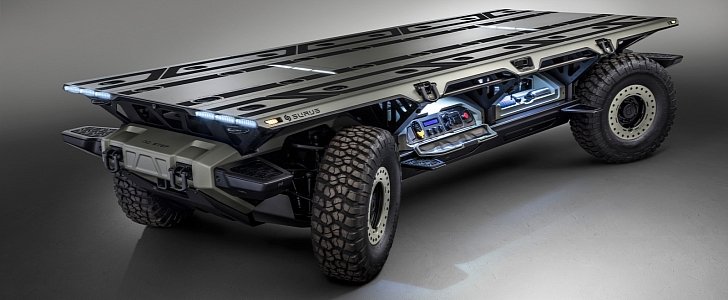While the hydrogen fuel cell technology is beginning to lose ground in its civilian applications, it still makes plenty of sense for the military - and that's something General Motors appears to recognize.
Using electric propulsion brings a number of very important attributes that internal combustion engine could never offer. First of all, there's the low level of noise. With stealth being an integral part of any mission - either to remain undetected or to get the jump on the enemy - the quiet hum of an electric motor (or several) is tens of decibels away from the gurgling of a diesel engine.
Then there's the instant torque. A military vehicle is likely to carry a heavy payload or to need to move quickly about, making the powerful electric motors ideal for the job. Plus, there's also the fact that this type of powertrain can provide a mobile source of electricity for other devices in the field while remaining perfectly silent.
The fuel cell system brings a few other advantages over the classic battery solution. For one thing, it can be a source of water. As we all know, the only residue from the chemical process that takes place inside the fuel cell is pure H2O, which could be a valuable resource in some places of the world.
Second, refueling takes a lot less time than recharging a large battery. If making liquid hydrogen and having it readily available for the entire population is a problem, it sure is a lot simpler for the Army, where the scale is significantly reduced and everything operates under just one management.
With all these in mind, General Motors has unveiled the Silent Utility Rover Universal Superstructure, or SURUS. This electric autonomous vehicle takes the meaning of the word "platform" a bit too literally as it's essentially a little more than that, albeit quite a hi-tech one.
The SURUS uses two motors for all-wheel-drive and can also steer with both axles for maximum maneuverability even in confined spaces. Its second generation Hydrotec fuel cell system gives it a maximum range of 400 miles (~640 km) over any kind of terrain thanks to its sturdy chassis, off-road tires, and suspension.
Its movement is controlled by an AI brain giving it full autonomy, even though GM doesn't really elaborate on that. We'd be very curious to know what kind of sensors it uses to navigate - especially over rough ground - since the released renderings show very few obvious ones (and no LIDAR).
The range of applications the SURUS would be fit for is endless, but at least as far as its commercial ones go, they could be limited by the availability of its fuel. The autonomous nature of the SURUS means it could easily form platoons and even operate with other potential autonomous vehicles.
The SURUS will be shown at the AUSA (Association of the United States Army) meeting starting this Monday and will continue testing throughout the winter and into 2018. We'll have to wait and see whether there's interest in the self-driving platform, but even if it isn't the SURUS, we're pretty sure something like this will make its way into the Army sooner rather than later.
Then there's the instant torque. A military vehicle is likely to carry a heavy payload or to need to move quickly about, making the powerful electric motors ideal for the job. Plus, there's also the fact that this type of powertrain can provide a mobile source of electricity for other devices in the field while remaining perfectly silent.
The fuel cell system brings a few other advantages over the classic battery solution. For one thing, it can be a source of water. As we all know, the only residue from the chemical process that takes place inside the fuel cell is pure H2O, which could be a valuable resource in some places of the world.
Second, refueling takes a lot less time than recharging a large battery. If making liquid hydrogen and having it readily available for the entire population is a problem, it sure is a lot simpler for the Army, where the scale is significantly reduced and everything operates under just one management.
With all these in mind, General Motors has unveiled the Silent Utility Rover Universal Superstructure, or SURUS. This electric autonomous vehicle takes the meaning of the word "platform" a bit too literally as it's essentially a little more than that, albeit quite a hi-tech one.
The SURUS uses two motors for all-wheel-drive and can also steer with both axles for maximum maneuverability even in confined spaces. Its second generation Hydrotec fuel cell system gives it a maximum range of 400 miles (~640 km) over any kind of terrain thanks to its sturdy chassis, off-road tires, and suspension.
Its movement is controlled by an AI brain giving it full autonomy, even though GM doesn't really elaborate on that. We'd be very curious to know what kind of sensors it uses to navigate - especially over rough ground - since the released renderings show very few obvious ones (and no LIDAR).
The range of applications the SURUS would be fit for is endless, but at least as far as its commercial ones go, they could be limited by the availability of its fuel. The autonomous nature of the SURUS means it could easily form platoons and even operate with other potential autonomous vehicles.
The SURUS will be shown at the AUSA (Association of the United States Army) meeting starting this Monday and will continue testing throughout the winter and into 2018. We'll have to wait and see whether there's interest in the self-driving platform, but even if it isn't the SURUS, we're pretty sure something like this will make its way into the Army sooner rather than later.













